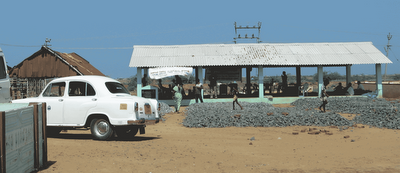It seems as if things are finally taking shape now. Last week I met several people, including someone from the UK charity which contributes to the hospital and the rural project, as well as the newly appointed director of RUHSA (Rural Unit for Health & Social Affairs, the department in which I am staying and working) and a lot of talk was talked. Obviously I contributed. But now there is a firm project which is about to get underway.
To give you a little bit of background (skip this if it's boring - there will be no hilarious exploits on buses over the next few paragraphs), RUHSA was set up as an independent Unit in 1977 to serve the social and healthcare needs of a specific region or "block" in Vellore district. In it's early days it set up agricultural projects, small holdings, self-help groups where women could generate their own income and therefore independence and a small hospital with 70 or so beds was built with outpatient, casualty, inpatient and surgical capacity. The block is divided into 39 Panchayats or village groups with a total population of around 120,000. RUHSA built peripheral service units (PSU) scattered throughout the region from where healthcare and other economic or social projects could be administered. Each PSU was presided over by an RCO (Rural Community Officers) - who along with their volunteer army of Health Aides and Family Care Volunteers, formed the bridge between RUHSA services and the villagers.
In 1985 RUHSA became a part of the Christian Medical College in Vellore, which despite it's name serves a mainly hindu population. It was started in 1902 by an extraordinary American woman with the fantastic name of Ida Scudder, who whilst staying with her parents as a young woman realised the need for female medical professionals. The story, as told in a radio interview by her in 1959 which I listened to on tape, goes as follows.
She was sitting at home one evening looking after her mother who was unwell. Her father, a medic was in the back. There was a knock on the door and Ida went to answer it. A Brahmin stood outside.
"Please memsahib, my wife is very sick, please come and help".
Ida said she would fetch her father but the Brahmin was horrified that a man would attend his wife who was in labour. He implored her to come, but she said she had no skills and could not help. Dejected he left. Ida returned to her seat feeling useless.
An hour or so later, there was another knock on the door. A
Muslim man stood outside.
"Please madam, please help my wife who is very sick", he implored, when she opened the door.
Again she said that she had no skills but she would fetch her father. Again the man said that only a woman could attend his wife. Once again a disappointed and unhappy man left her house with no help.
As she sat feeling desperate for these women, a third man came to the door with the same request. Again she could not help. All three women died.
Ida felt that she had been shown the path to her future. She returned to the States, enrolled as the first female medical student in her university and graduated aged 30 in 1900. She returned to India, despite having promised before her revelation, that she would not stay in such a dirty, dusty, hot and barbaric country, and set up roadside clinics delivering healthcare to villages, initially on foot and then using a one cylinder Peugot, the first car of its kind in India. She soon built a hospital and set up a medical college initially catering for female graduates only - the first male students were accepted in the late 40's- to ensure that the women of the villages could have ongoing access to healthcare. It is now a vast internationally reknowned hospital, one of the best in India, with 1900 beds (including rural units) and three community departments of which RUHSA is one.
Many of RUHSA's early projects are self-sustaining and therefore they have withdrawn. The hopsital is still running and seems very busy. The main focus now seems to be training and development, both of healthcare students and local people in health care matters. Consequently the PSU's are a vastly underused resource. Some are in a ruinours state. The project therefore is concentrating on one of the better PSU's and, in conjuction with consulation with the village, is going to set it up as a community cetre to serve the needs of the poorest of the poor, some of whom don't even get two meals a day.
The first stage therefore, is to go to the village and do a participatory rural appraisal, where we assess the needs of the pooorest of the poor and then we figure out a way of improving things.
If you've stuck with me to the end of this, thanks for your attention. If you are interested to know more about FOV and CMC there are links on the left. I will keep you posted about how things progress. It is really interesting to see social care developed from scratch and I will learn an enormous amount. Exactly how useful I will be to them, I don't know, but I'm keeping that quiet.....


